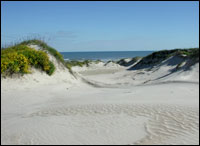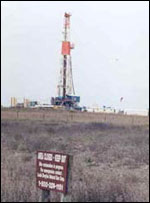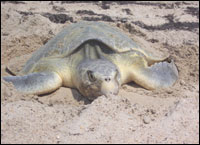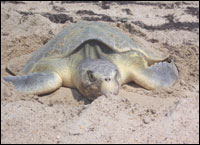
Life’s a beach — and then you die.
Photo: NPS.
This time of year, a slim strip of Texas beach known as South Padre Island is hopping with bikini-wearing, hard-drinking college students on spring break. On neighboring North Padre Island, however, the scene tends to be quite a bit calmer. Nearly 70 miles of this Gulf Coast barrier island are national seashore, managed by the National Park Service; except for one heavily visited five-mile stretch, the place is inaccessible by passenger car.
“There are miles and miles of miles and miles,” says Johnny French, a retired U.S. Fish and Wildlife Service biologist who frequently fishes at the seashore.
Those miles and miles make for a lot of peace and quiet, and a lot of fine wildlife habitat. The seashore is the longest undeveloped stretch of barrier island in the world, and more than a dozen threatened and endangered species use its extensive dunes, mudflats, freshwater marshes, and white-sand beaches. Four species of sea turtles are known to nest on the seashore, including the seldom-seen Kemp’s ridley turtle. Donna Shaver, chief of the division of sea turtle science and recovery at Padre Island National Seashore, says the Kemp’s ridley has long been considered the most endangered sea turtle in the world. Over the past two decades, the seashore has hosted more than half of the Kemp’s ridley nests documented in the United States.
But there’s a ruckus coming to Padre Island National Seashore, and it could do a lot more damage than a spring-break beer bash. The seashore, like a dozen other areas under NPS purview, doesn’t encompass the oil and gas deposits underneath it. On Padre Island, these “subsurface” rights are owned by the state of Texas and various private companies and individuals. Some of those underground owners are hoping to pump natural gas out of the national seashore, and the Interior Department and key congressional leaders are looking to give them a hand.
Mineral Wrongs
Padre Island National Seashore has never been a completely pristine refuge for turtles and tourists. When Sen. Ralph Yarborough of Texas convinced his congressional colleagues to protect the seashore in 1962, he agreed to a major compromise: The mineral rights beneath the island sands would stay in state and private hands, and the NPS would allow continued access to those rights. Energy development had begun on the island in the 1950s, and during the ’60s and ’70s several dozen oil and gas operations were conducted within seashore boundaries.
When industry interest in oil and gas development at Padre Island dropped off during the ’80s and early ’90s, says former National Parks Conservation Association staffer Randall Rasmussen, “we were hoping the national seashore would go back to being a natural seashore.” The end of the millennium, however, saw a boom in the natural-gas market and increased enthusiasm for the seashore’s estimated 80 billion cubic feet of gas deposits.

Well, well, well: a BNP well
on Padre Island.
Photo: Lonestar Sierra Club.
In 2001, the NPS completed an oil and gas management plan that projected up to 18 gas wells within seashore boundaries in the next 30 years. In August 2001, BNP Petroleum Corp., a Texas-based company that holds leases and options covering more than 60,000 acres of the national seashore, submitted its first application to drill within the park. The NPS approved that permit in February 2002, approved two more in November 2002, and late last month gave the OK for a fourth well. There are currently two other active gas wells at Padre Island, operated by the Houston-based company EOG Resources, Inc.
One of BNP’s permitted wells has already been in operation, but company CEO Paul Black says it was not commercially feasible. He says BNP plans to start operations at a second well within the next few weeks. Future drilling at Padre Island, he says, depends on results from the approved operations: “If we have success, we’ll go ahead, and if we don’t, we won’t.”
Since there are very few roads on the seashore, BNP trucks move around the island the same way most tourists do: They drive on the beach itself. That worries a lot of environmentalists, who say the large trucks — as big as 18-wheelers, and as many as 20 per day — not only disturb visitors but also increase the threats to sea turtles and other wildlife. The NPS has imposed several significant restrictions on BNP, including a ban on industrial beach traffic during the peak sea-turtle nesting period. BNP CEO Black is confident that these measures will protect the seashore’s wildlife and its habitat, but opponents of the projects say speed limits and other rules are not consistently enforced.
“It’s so disheartening and discouraging to know that there’s going to be drilling [on the island] and trucks up and down the beach,” says Carole Allen of the Sea Turtle Restoration Project. “We do know that trucks will pack down the sand and make it more difficult to dig nests — and no one really knows what the effect of the vibrations [caused by truck traffic] will be. We can’t seem to get the point across that this shouldn’t happen.”

See turtle: a Kemp’s ridley does its
thang.
Photo: NPS.
In December 2002, the Sierra Club tried to drive the point home. It sued the NPS, Interior Secretary Gale Norton, and the U.S. Fish and Wildlife Service over the drilling permits. The group charged that even though the NPS had stated that the projects posed some danger to protected species, the agency had not properly consulted with the FWS about the environmental effects of the development. The following spring, the district court acknowledged that there was some risk to the Kemp’s ridley turtles, but ruled that BNP could move forward with its plans. An appeals court upheld that decision last August.
If Congress approves the current version of the embattled energy bill, drilling at the seashore may gain more momentum. A provision now in the Senate version states that it is the “sense of Congress” that “any regulation of the development of oil, gas, or other minerals in the subsurface of the lands constituting Padre Island National Seashore should be made as if those lands retained the status that the lands had on September 27, 1962.” The national seashore was created on Sept. 28 of that year.
Though this resolution would not carry the force of law, it would demonstrate Congress’ desire to weaken the NPS regulations governing energy development. “It would treat the seashore as if it never existed for the purposes of oil and gas exploration,” says Craig Obey of the National Parks Conservation Association.
Done Deal?
Opponents of drilling at Padre Island say the federal government should choose another path. They point out that in May 2002, President Bush made a federal commitment to purchase the privately owned mineral rights under Big Cypress National Preserve and two national wildlife refuges in the Florida Everglades. Though Congress has not yet agreed to the deal’s $120 million price tag, Texas activists hope the president will make a similar commitment to his home state.
Sierra Club regional conservation organizer Chris Wilhite says the group aims to gather 20,000 signatures on a petition that urges Bush and the Texas congressional delegation to “do the right thing” and support a buyout of the state and private mineral rights under Padre Island National Seashore. The Sierra Club plans to hold town meetings and activist trainings in Texas and other states beginning next month.
“The national parks are not where you ought to be having gas drilling,” says Pat Suter, a longtime resident of Corpus Christi, Texas, and the chair of the Coastal Bend Sierra Club group. “We’re agitating as hard as we can.”
But these days, electoral politics are making federal conservation efforts a tough sell in the Lone Star State. While Bush has plenty of good reasons to court votes in Florida, Suter concedes, the outcome in Texas is a bit more predictable: “Bush has Texas sewed up.”


